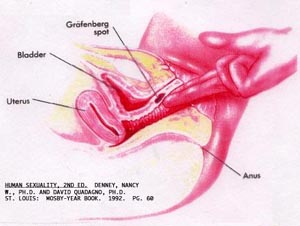

And now at last, therapists, researchers and drug companies are working on a new and revolutionary understanding of women, of the ways in which their bodies function. Their is even work being done on the evolutionary meaning of orgasm.
There were great
hopes for Viagra, which as yet have not been realised. But both male and
female genitals are endowed smooth muscle tissue that engorges with blood
during arousal.
Using Viagra, or some adaptation of the same principle, may help to
the relevant tissue in the clitoris, as the male version of Viagra
idoes in the penis, allowing the vessels in the organ to swell with
blood.
Early tests were unsuccessful to say the least. Women were given doses
of Viagra and a placebo. Neither could be said to have been effective.
However Newsweek magazine recently quoted Cheryl Bourque, an analyst
at Decision Resources, referring just to drugs developed for
men and adapted to women's needs and projecting that that by 2008,
the market for treatments for women, could hit $1.7 billion.
That's just for starters, considering that the long-term plan is for
prescribed drugs conceived and catering specifically for women.
- Jennifer Berman
and her sister, Laura, seem never to be off the TV in America, and on
programmes like Larry King Live, which are shown world-wide.
Jennifer is a urologist. Linda is a sex therapist. They freely offer patients vibrators, they allow their patients to watch monitors revealing the goings-on of their own organs, and they work with the mind and the body. They are probably too touchy-feely for the average European or English woman, but they do get results and some of what they teach is revelatory.
- They are among
those who are finally realising that women are not like men in their
approach to arousal and release, in the desire to get started and finished,
or to compartmentalise sexual activity. It's true that they do monitor
the flow of blood to a woman's genitals, but the woman's life,
the relationship she has and her self-esteem are all of tremendous importance.
A sex aid, a drug and a holiday near a beach may be good medicine. The
cure may come when wifey gets something even simpler: like a compliment.
On the other hand, what do we know about a woman's anatomy?
Shebang interviewed 30 men, none of whom could state where the G-spot is.
- Boys, the Gräfenberg
spot is here:

- In a Peter Nichols
play a man in drag is asked by an inexperienced boy: 'Where's the clitoris?'
The drag queen replies, in a deep male voice: 'Search me'.
It can be fun searching for a clitoris, but even women, don't necessarilty know all there is to know about it. Newsweek recently described how a fourth year female medical student didn't know how big the clitoris is. One centimetre. Or ten.
Answer? The clitoris is 10 centimetres long.
New finding suggest that stimulating the same branch of the nervous system which shuts down sexual arousal in men might facilitate it in women.
The old straight line or arrow approach to orgasm is being re-examined too. Desire to arousal to orgasm is now being adapted. The better image is a circle: Desire, arousal, orgasm and satsifaction.
And there could be any number of moments of intereference or turbulence at any stage in that cycle.
And this week's disappointment dampens next week's attempted joy.
That's a cycle, a circle, too.
Medication with hope:
Most of the drugs currently being tested target arousal.
Jump-starting the libido is one thing. Many women want help in getting that orgasm too.
The problems involved are far more complicated than erectile dysfunction in men.
Viagra, or a version of it, may work for some conditions but not others.
A more targeted study, limited to postmenopausal women, is now getting started. Also being tested is a 'dopamine agonist' called apomorphine, recently recommended for approval for use in men, which sends electrical impulses from the hypothalamus to the genitals to trigger increased blood flow.
Earlier in June 2000 an apparatus called EROS-CTD came onto the market.It is, a clitoral suction device the size of a computer mouse that draws blood to the clitoris. It costs about 240 pounds - about 360 dollars.Hormone therapy is also fairly promising, if a little wayward at times.
Testosterone, for reasons no one quite understands, is involved in the sex drive of both men and women.
In their 30s and 40s, most women experience a 15 percent drop in testosterone levels. Removal of the ovaries, often a part of hysterectomy, reduces testosterone production to near zero.
At the University of California, Dr. Louann Brizendine has been experimenting with testosterone replacement therapy, in both oral form and patches.
Unfortunately, possible side effects include increased risk of heart disease and liver damage. Long-term consequences are unknown.
Also, the surges of desire can be very powerful, too powerful for polite company, at times.
Blood concentrations of estrogen vanquish the hot flushes and night sweats responsible for libido-killing insomnia and irritability. It also prevents some of the thinning and drying out of vaginal tissue.
After menopause, thinner, less flexible vaginal tissue can make sex so painful that the body recoils even when the heart is willing.
Virtually any form of estrogen - the pill Premarin, a patch, vaginal creams or vaginal rings kept in place for three months - improve vaginal tissue, Estrogen alone stimulates the uterine lining and increases the risk of endometrial cancer, women with an intact uterus are usually advised to pair estrogen with progestin-which blocks this effect-in a regimen called hormone-replacement therapy (HRT).